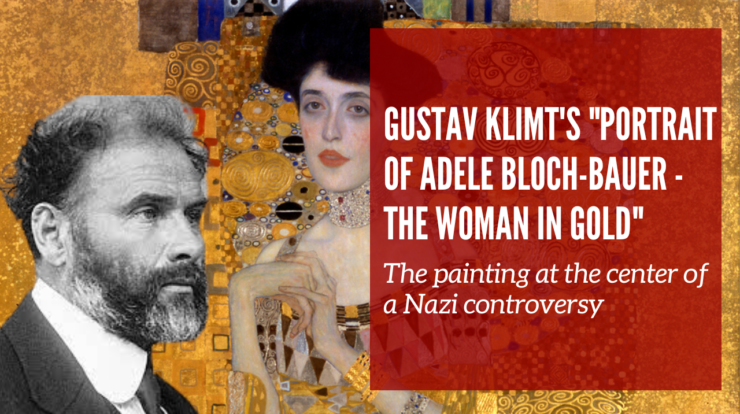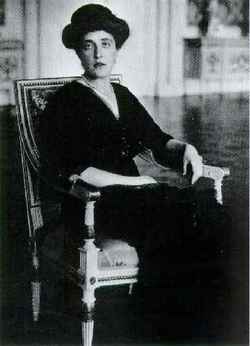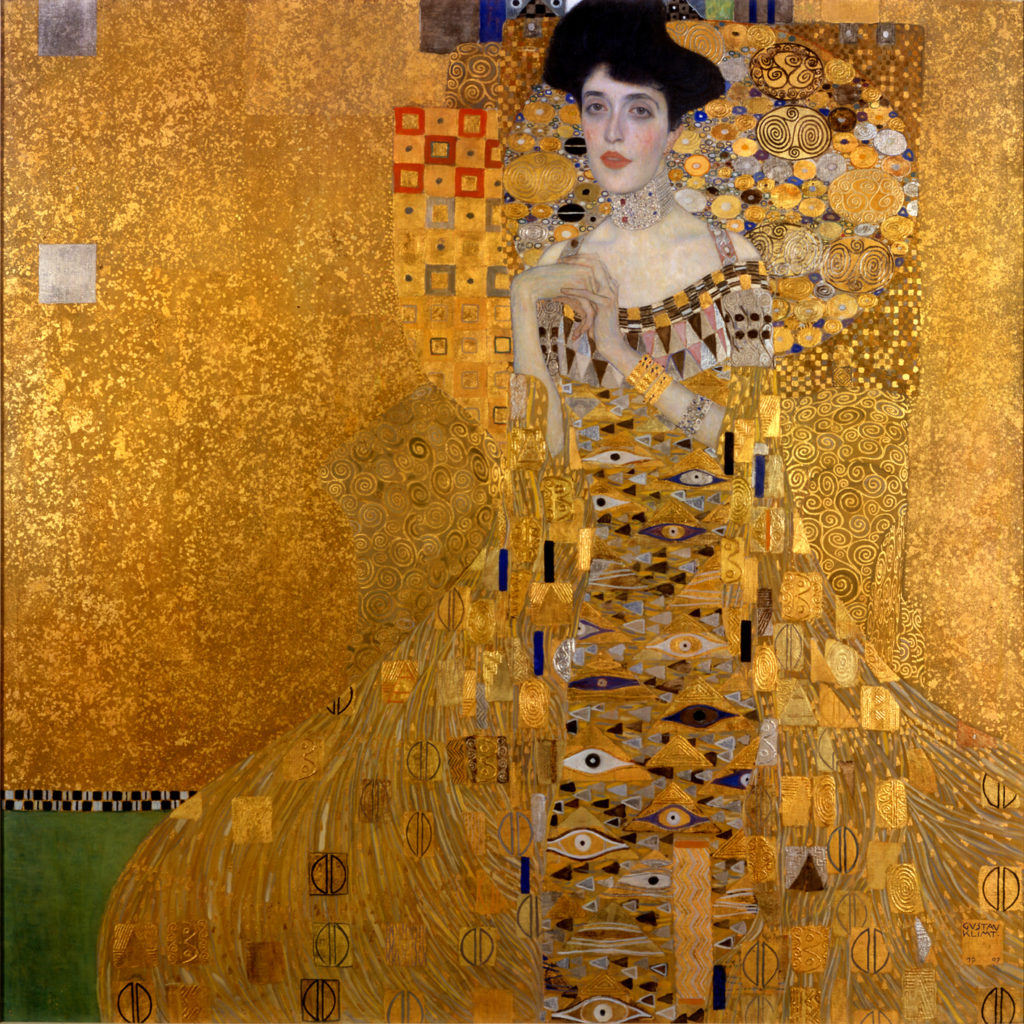
Gustave Klimpt’s painting “Portrait of Adele Bloch-Bauer – The Woman in Gold” has a long and complicated history, involving Nazis, legal battles, and finally, a new home in New York.
Commission
When Klimt accepted a commission from wealthy Jewish banker and sugar producer Ferdinand Bloch-Bauer, he could not have known how much trouble it would cause.

Bloch-Bauer commissioned the portrait of his wife Adele in 1903. He originally planned to give the painting to Adele’s parents as an anniversary present that year, but that didn’t quite end up happening.
Klimt undertook more extensive preparations for the portrait than any other piece he worked on, making multiple preparatory sketches and using an elaborate technique for the final piece that involved using gold and silver leaf and then adding decorative motifs in bas-relief using gesso. He didn’t end up finishing the piece until 1907, and the Bloch-Bauers kept the piece instead of giving it to Adele’s parents.
Relationship with Adele
This painting was the final piece Klimt created during his “golden phase,” but it wasn’t the first or the last time he painted Adele Bloch-Bauer. She had modeled for Judith and the Head of Holofernes in 1901, and he painted a second portrait of her in 1912. It’s possible that Klimt and Adele had an affair, though a lack of evidence has made it a controversial topic.

Whatever the nature of Klimt’s relationship with Mrs. Bloch-Bauer, she and her husband loved the portraits. When Adele made her will, she requested that all the couple’s Klimt paintings go to the Austrian Galerie Belvedere, though legally they belonged to Ferdinand, who chose not to honor her wish, at least not immediately after her death. Instead, he hung the portraits in his late wife’s room as a shrine to her.
The jeweled choker Adele wears both in the gold portrait and in the Judith painting she modeled for had been a gift from Ferdinand, and a little more than ten years after his wife’s death, he gave the necklace to his niece Maria as a wedding present.
Nazis steal the painting
The next year, in 1938, Ferdinand fled Vienna following the annexation of Austria by Nazi Germany. He left the paintings behind, and the Nazis seized them and much of his other property, falsely claiming that Ferdinand had evaded taxes of 1.4 million Reichsmarks. Hitler and other Nazi leaders claimed pieces from the Bloch-Bauer collection at reduced prices. One Nazi leader ultimately took the choker gifted to Maria Altmann and gave it to his wife.
Eventually, the portrait of Adele was transferred to the Galerie Belvedere and retitled Lady in Gold to remove all reference to its Jewish subject.
Ferdinand’s last will and legal battles
In 1945, the year he died, Ferdinand Bloch-Bauer made a final will that left his entire estate to his nephew and two nieces.
He didn’t name the paintings specifically, thinking they had been lost forever.

In 1998, long after the war and Bloch-Bauer’s death, the Austrian government introduced the Art Restitution Act to find out which works of art should be returned to their rightful owners.
Marie Altmann filed a claim with the restitution committee for the return of six Klimt paintings. The committee claimed that the museum legally owned the paintings because of Adele’s will.
After a lengthy legal battle, Altmann and the Austrian government came to a settlement, and five of the six paintings, including the Portrait of Adele Bloch-Bauer, were returned to Altmann. She sold the piece to businessman and art collector Ronald Lauder, who placed the piece in Neue Gallery in New York.
Conclussion

In conclusion, the painting “Portrait of Adele Bloch-Bauer – The Woman in Gold” by Gustave Klimpt has a long and complicated history. The painting was originally commissioned by wealthy Jewish banker and sugar producer Ferdinand Bloch-Bauer, but ended up being kept by the Bloch-Bauers instead of being given to Adele’s parents. It is possible that Klimpt and Adele had an affair, though a lack of evidence has made it a controversial topic. Ferdinand fled Vienna in 1938, leaving the paintings behind, and the Nazis seized them and much of his other property. eventually, the portrait of Adele was transferred to the Galerie Belvedere and retitled Lady in Gold to remove all reference to its Jewish subject. In 1998, the Austrian government introduced the Art Restitution Act with the intent of finding out which works of art should be returned to their rightful owners. Marie Altmann filed a claim with the restitution committee for the return of six Klimpt paintings, and after a lengthy legal battle, five of the six paintings, including the “Portrait of Adele Bloch-Bauer – The Woman in Gold”, were returned to Altmann.
What are your thoughts on the dramatic history of “Portrait of Adele Bloch-Bauer – The Woman in Gold”?
What do you think of the painting “Portrait of Adele Bloch-Bauer – The Woman in Gold”? Do you think the Austrian government should have returned the painting to Marie Altmann? Do you think Ronald Lauder should have placed the painting in the Neue Gallery in New York?
Y’know, I think that little composite you put together under the title looks better than the full painting.
I feel so privileged to have seen these paintings in the Belvedere when I visited Vienna in the early 90’s. Personally, I think they should’ve remained there in his home country and to honor her will.
Her will said after her husband’s death, the Nazis stole them 5 years before he died. Additionally she was not the owner and thus had no standing to give them away.
I saw the movie in Netflix. My feelings about this controversy: Yes! I am glad Marie was able to have it. And New York and anyone who wants to view it is enjoying this masterpiece now.
And Marie and her family have enjoyed the financial rewards from this painting! Good deal for me. 😀
All kinds of injustice in this story, including the property rights of women in marriage, not to mention the travesty of the Nazi era and subsequent treatment of property. That said, the outcome for these paintings seems fair given what the family had lost.
Seeing the original painting the Neue Museum is worth a trip to New York. Reproductions don’t do it justice. It’s a truly luminous work and much larger than you might expect.
Since the period in which Adele Bloch-Bauer wished to donate the painting to the gallery Galerie Belvedere occurred before the Nazi party gained power, she might well have changed the way she felt about donating it. But since she died, no one is ever going to know. Yet, I think it really should have stayed with the Galerie Belvedere with the proviso to change to name back to its original title. I believe that this in itself would make a valuable statement and for the Galerie to be transparent about who she was and the Nazi plundering as it related to her story.
I agree with your statement. The painting should go back to the original title out of respect for the family. Adele Bloch-Bauer’s will stated the paintings were to go to Galerie Belvedere. I believe that should be honored.
There will never be enough we as a society can do to make reparations to the Jews. What happened to the Jews was abhorrent. What is continuing to happen to the Jews is abhorrent. Every effort must be made to return their stolen items to them.
Seeing any or all Klimt paintings is a joy and a gift. One could stare at them for hours and see or think something new every minute.
I hope to see this painting in person some day.
The movie, “Woman In Gold,” was very compelling. According to the movie script, Marie Altmann was apparently willing to leave the painting in Austria had the museum been willing to meet her terms. That failed and full out legal battle ensued.
Given the history and considering the comments made, what could prevent a modern controversy on the disposition of an art collection or any part of it today? I would think that the establishment of a legal trust for the art assets that became irrevocable after the death of one of the original trust owners would ensure that the desires of all parties concerned would be followed.
I think that the will should have been honoured. Tracing the history of the paintings back to the original owners and purchasers, whether they decided not to give them away as gift or not, I think that the wishes of Adele Bloch-Bauer should have been the deciding factor.
The Holocaust? Hello! What if you left paintings you treasured to someone you believed to be a good friend. But after your death, they began persecuting your family, then did a home invasion and killed everyone who didn’t escape in time. Then they took over everything you owned including your house. After what they did would you still want them to have the paintings? Watch the movie “The Woman in Gold.”
Thank you Jason for your great informative article about Gustav Klimt and his magnificent portrait of Adele Bloch-Bauer.
This painting was one of my most favorite paintings to share with my students in Art History. I had the opportunity to see the painting at the Belvedere while living in Central Europe during 1991. The gold leaf is illuminating and the background textural design pattern weaves your eye throughout the work to settle on her beautiful face, shoulders and clasped hands.
Klimt’s portrait is an outstanding addition to New York City and will be enjoyed by all throughout the West.
I enjoyed seeing this painting at the Belvedere Palace in Vienna twice and have been to the Neue Gallery and plan to go back. A stunning painting to be sure!
The painting is brilliant. I saw it in the 1980’s in Austria. Whether it belongs in Vienna or New York is a troubling question. Personally, I have no problem with where it rests now as long as it is on public display which seems to me the crux of the sitter’s wishes.
GREAT STORY JASON….LOVE HIS WORK……..BEN
I agree with Deborah S. It should be in it’s home country per her will, and with her name as the title. I am glad it is in a museum where people can see it, rather than in the home of a private collector.
This is such a small part of art ,and valuables stolen from Jews, by nazis, but much ,much more is still held by the banking thieves in Switzerland they know who it belongs to ,but claims absolutely rights to billions of stolen property deposited by Jews, now dead refusing to honor the rights of inheritance for families of their property ,they are the true neo nazis
Where is the world court ?
the painting was stolen by the Nazi who then possessed the painting .Then the Americans beat the Nazis in world war two ..So that said ,the Americans own the painting …
The movie is a poor reflection of the situation concerning the picture. Read the book. One of the problems with The will is (if I remember right) that Adele actually left the paintings to her husband with the expressed wish that they may end up eventually into the national gallery. The book is a very good read.
I saw the “Portrait of Adele Bloch-Bauer – The Woman in Gold” at the Neue Galerie on Fifth and 86th streets in Manhattan last week. For those who have not seen the real painting, the picture of the painting alone in the article is much darker than it actually is. The picture of it with Frauline Altman, Ronald Lauder and
Neue Galerie Director Renée Price, is what it in fact looks like. The Neue is an interesting representation of Mr. Lauder’s taste in art. Especially, his interest in late 19th/early 20th century German expressionism.
I have had the privilege to visit the paintings of Klimpt in the Belvedere and the Neue gallery.
I feel that justice has been served. The Nazis stole all the possessions and some of the art was returned to its rightful owner.Maria Altman was not interested in the money But JUSTICE.
In this case, Justice was served.
Jason:
I sure enjoy your ‘a moment in art history’ blog posts. Just enough meaty information that often send me off for a Goggle search. Thanks for keeping expanding my general knowledge about art and artist.
I’ve been debating whether or not to post on this apparently contentious subject, but I feel that I should both as an artist and the daughter of a Jewish refugee who fled with his parents from Nazi Germany to the United States. Had they not escaped, I wouldn’t exist and neither would my art.
I recently watched “Woman in Gold” because it was about to be taken off Netflix. I’d put the movie on my queue because I was curious about the art aspect of it (and Helen Mirren!) but had avoided it because of my family history. My dad never talked about his time in Germany. He left when he was 7 years old but had some memories of the Nazi’s. So I generally avoid anything related to the Nazi’s.
So here are my thoughts. First, as a Jew, Adele clearly would not have willed the paintings to the museum had she known that the Nazi’s would take over Austria. Second, her will stipulated that the painting were to be DONATED to the museum, not STOLEN and placed in the museum. So while I understand that Austria lost very valuable, beautiful art due to a past the museum & government aren’t responsible for, I have to side with the court’s decision to return the work to their rightful owner.
Jason, I wonder if you’d consider a post on the wider issue of so stolen art in museums around the world (US, included)?
I saw the original painting in the Neue Galerie in NY and it was quite a special moment for me. Knowing the story of the painting and all its detours brought so much depth to my experience! Being able to see the details in person added to my hold-your-breath experience.
The issue of stolen art is very complex and the Restitution Committee (not sure this is how they are called) is still hard at work, so many years after the war. I wish museums and individual collectors who now possess such paintings would honor their provenance – despite all the detours. But I can understand how difficult it is, sometimes, to prove it.
Nothing can ever undo the atrocities, the torture, the untold deaths and terror, the grief of those left alive. Imagine how far that would have reached had Hitler not been stopped.
It is gratifying, though to see some wrongs righted.
Regarding the gossip surrounding the relationship between Artist and model: These were real people, with real feelings, not merely characters in a story for entertainment. Imagine how both families must have felt about the speculation at at the time, assuming it was not true…and as decent people, we OUGHT to assume innocence where no evidence is present. When an artist finds a compelling face to paint, why would it be a surprise that he would paint her multiple times? What artist hasn’t painted a favorite subject thus?
I saw many of Klimt’s works at the Neue with my wife. We named our dog Adele after her but most people think we named her after the singer. Whether I decide to tell them she’s actually named after the model depends on my mood and whether I think they’ll know who Klimt is or his work. I’m toying with the idea of doing a portrait of her like the Klimt Portrait but with my mediums of oil pastel and watercolor. Should be challenging. What do you think?
I feel that the paintings should be returned to the family and then they should decide on what happens to them they was cheated by the nazis stolen what did not belong to them the necklace gone and more and likely never seen again so it’s time to do right by the family 👍🏽
The paintings WERE returned to the family – but only after a lengthy legal battle because the Austrian museum didn’t want to acknowledge the fact that the paintings were stolen. Woman in Gold was sold to the gallery in New York by the Bloch-Bauers’ heirs.
I think ALL of the paintings belong to the FAMILY (NOT just 5 out of 6). I just wish Adele’s painting had been donated to the US National Holocaust Museum as an example of stolen art.
Since the case is supposed to be about the law, Adele did NOT own the paintings and therefore could not legally will them to anybody. But even if she had been the legal owner of them, the will said she was making a “kind request” (aka ‘wished’) that her husband would leave it to the State Museum in his will as opposed to directly and specifically saying that they were “ARE TO BE GIVEN” to the museum. Words have meaning and there is a difference between wishing and directing. If she had said, “After my husband’s death, the estate MUST give to paintings to the State Museum” or if it has said something like “I bequeath my paintings to the State Museum but they have to wait to receive them until after the death of my husband” (of course, that phrasing would be a problem since they were stolen before his death), then there could be a different argument but that is NOT what it said. Wishing is the same as hoping and hoping does NOT always work. Maria knew the painting should be viewable to the public and so it is (plus this way, she would not have to decide which of her children would receive them and thus avoiding any sign of favoritism or jealously that could happen).
What I am even more interested in finding out is, where is the cello and necklace NOW. The cello, the necklace (which belonged to Maria when it was stolen) and all of the other of the belongings stolen from the family need to be tracked down and given back to the family.